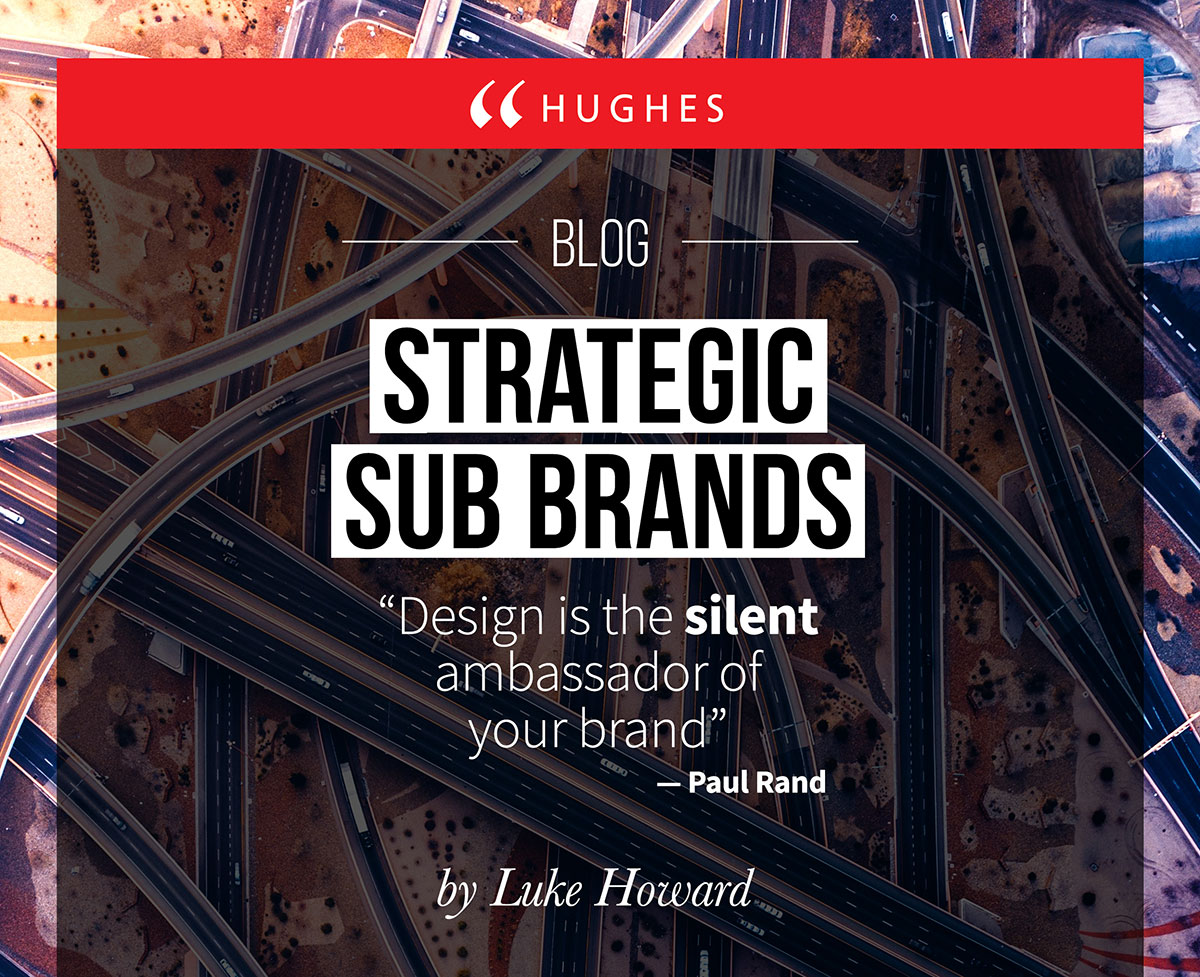

Blog: Strategic Sub Brands

What Route to take?
What route your sub brands take needs to be strategically worked out, well before visual design takes place. There are vital issues which need to be addressed, and this article will help you work through them.
What this article will cover:
- Going down the linked route
- Going down the individual route
- Key questions to ask first
- Visual identity for sub brands
- Conclusion
What are the benefits of anchoring your sub brands to the parent? Prestige, history, quality, trust, familiarity, can't afford to water down the parent brand? What are the cons? Tells the wrong story, completely different target audience/category, or the parent brand is irrelevant to the sub brand in another way and linking them would create confusion?
Linked route
If closely linked to the parent brand and there's an underlying purpose that resonates throughout each of the sub brands offerings, the closely linked sub-branding route would make more sense. Can you leverage benefits from one sub brand to another, and from the child to the parent?
Individual route
A much more individual sub brand approach may be the appropriate option for the sub brand. The parent brand could act as an almost silent umbrella brand to the sub brands. Of course, the flip side of this is neither gets to benefit from the other's successes or brand awareness either. This can be a drawback in some scenarios or it can be the wisest direction to take.
Key questions to ask
The answer on which direction to go can often be found by asking these questions. This could be done through an internal analysis, or market research/polling on brand sentiment:
- Who are your customer segments?
- Do these differing segments want to be associated with one another and why?
- Do the brands serve distinctly different audiences?
- Do the parent and child brands have distinctly different brand promises and corporate mission?
- Does the new product/service/brand fulfil upon your existing parent brand's deeper purpose and vision in anyway?
- Is there absolutely no need for the child brand to rely on the ‘halo effect’ of the parent, and will it be strong enough to stand on its own?
- Is the parent brand strong enough, and can it afford not to gain from the association and recognition of the child brand being closely linked to it?
- Linked to above, is there a risk of brand dilution?
- Are there enough resources to promote and maintain the new brand?
Visual identity for the sub brand
Only once you have established if, and how strong the connection between the parent and child should be, you begin the visual design process.
BUT…. Although this blog has so far presented two different routes for sub brands (Linked and Individual), there are in fact four generally accepted routes for your brand family.
- And Sub brands are just one option. Let me explain:
The four options are:
1. Branded House (Linked route)
2. Sub Brands (Linked route)
3. Endorsed Brands (Linked route)
4. House of Brands (Individual route)
1. Branded house
has a clearly defined parent brand, e.g. FedEx, with the child brands visually linked to the parent brand, and sometimes including a visual discriminator. Like a changed word or altered colour.

2. Sub-Brands
use the visual elements from the parent brand, with clear distinctive elements of the child brand. These child brands help boost the corporate brand while remaining differentiated.

3. Endorsed brands
are where the child brand is strong and differentiated from the parent, and allowed to have its own visual identity. However the parent is seen to always endorse the child. This technique is often seen as the first move when a larger parent takes over a smaller brand. The parent wants to get its name out there but doesn’t want to interfere with the reputation of the established child brand. e.g When Bega purchased Peanut butter from Kraft.

Another example of Endorsed Brands is the Kellogg's range:

4. House of Brands
This the pure individual route where the parent owns the brand but is not connected in any way visually to the child brands. These children are decentralised companies targeting diverse markets. Most people aren’t aware of how many different child brands come from a holding company e.g. Unilever

Conclusion
At their core, child brands survive and thrive on their ability to deliver on a compelling promise and to stand head and shoulders above their competitors. By aligning your brand architecture strategically with the brand promise, you can bring clarity in the marketplace and ensure business prosperity. And the visual design should silently strengthen and endorse this message.
Hughes PR regularly works with brands spanning from start-up to large companies. To discuss how we can help strengthen your brand identity please contact:
Luke Howard
Hughes | Graphic Design
luke@hughespr.com.au
I’m standing on the shoulders of some very smart experts and have drawn a lot of inspiration for this article from the Harvard Business Review’s article The branding logic…, Jeff Pruitt’s article 4 branding structures..., Charlotte Rogers’s article How to avoid fragmentation… and Emily Marchak article The pros and cons…
Recent News
- Blog: Navigating the changing media landscape
- $48M affordable housing hub revives beachside site
- Covid success story: SA digital transformation start-up expands interstate
- Industry leader Mark Smith appointed National Pharmacies CEO
- Mellor Olsson appoints new CEO
- Indonesia AirAsia touches down in Adelaide, enabling affordable connectivity across Asia via Bali
- Playgroup reimagined: Elders and children connect at ACS's Aboriginal aged care home
- Apartment living reaches new heights with $120 million Parkline development topping out
- A Fresh Take on Strawberries: Premium Packaging that Looks as Good as it Performs
- Paper & board packaging leader unboxes new global HQ in Adelaide
- Lutheran Homes Group brings its high-quality aged care to regional Victoria in historic expansion
- Blog: The growing AI threat - what it can mean for your brand and reputation
- CH4 Global named as one of the world’s top Sustainable Development Goal leaders
- Scotch AGS Vietnam’s inaugural SACE graduates go global
- Gen Z and the future of AI
- Qantas international services return to Adelaide
- Blog: Let’s get (a)political: all you need to know about elections and public relations
- The world’s most valuable dog toy revealed in the lead up to Guide Dogs Day
- Skytrax names Adelaide as best regional airport in Australia & Pacific region
- Indonesia AirAsia To Touch Down in Adelaide for the first time in June Fares on sale today starting from just AUD$199*!








